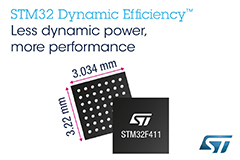Jun 28 2014
New STM32 Dynamic Efficiency(TM) microcontrollers from STMicroelectronics, a global semiconductor leader serving customers across the spectrum of electronics applications, improve the power-saving performance of data batching - the technique also used in Google's latest Android 4.4 (KitKat) operating system to maximize battery life - and extend the advantages to many more applications besides smartphones and tablets.

Android 4.4 uses a low-power sensor hub to manage "always-on" sensors like accelerometers or pressure sensors, allowing the main system processor to consume less battery energy. ST's STM32F411Dynamic Efficiency microcontrollers, which are engineered to deliver more performance with lower dynamic power and higher integration, are a perfect fit for sensor-hub applications. The new STM32F411's Batch Acquisition Mode (BAM) saves up to 50% extra power by storing sensor data directly into SRAM while its own CPU core sleeps. The core wakes briefly to process this stored data before returning to power-saving mode.
As a versatile device used in a wide variety of industrial and consumer applications, the STM32F411 brings the advantages of BAM and other power-saving innovations including its new Flash-STOP mode to applications like industrial controls, medical monitors, building automation, and wearable technology. A choice of compact packages down to 3.034mm x 3.22mm allows use where space is tight.
The STM32F411 features the ARM® Cortex®-M4 processor core with DSP and Floating-Point Unit (FPU), and has up to 512Kbyte of Flash with high SRAM capacity of up to 128Kbyte. Also leveraging ST's ART Accelerator(TM) branch cache[1], 90nm process, and voltage-scaling capability to minimize dynamic power and boost processing performance, the new STM32 Dynamic Efficiency line is the industry's first M4-class device to achieve RUN mode current of 100µA/MHz executing EEMBC® CoreMark(TM) code from Flash with peripherals off while also being able to run up to 100MHz to deliver 125DMIPS. Current in STOP mode is also very low at just 10µA typical with all SRAM content and context saved.
With the option of an extended temperature range of -40°C to 105°C, low-voltage supply down to 1.7V, and rich peripherals, the STM32F411 can be deployed in demanding environments and applications. The peripheral set includes a 12-bit 16-channel ADC up to 2.4Msample/s, up to 11 timers including motor-control timer and general-purpose 16-bit and 32-bit timers, and versatile communication interfaces. These include three I2C ports up to 1Mbit/s, three USARTs up to 12.5Mbit/s, a USB 2.0 OTG Full Speed interface with embedded PHY, five SPI ports up to 50Mbit/s with five I2S audio interfaces, and an SD/MMC interface. These features are available with all package options, including the lowest pin-count devices.
The STM32F411 is the entry level to the STM32F4 high-performance series. It is in production now, and is supported with a development ecosystem including the STM32Nucleo open hardware platform and STM32Cube software tools and embedded software. A Discovery kit will also be available in Q4 2014. Budgetary pricing is from $2.97 for the STM32F411CCY6 with 256KByte Flash and 128KByte SRAM in WLCSP49 package, for orders of 10,000 pieces per year.